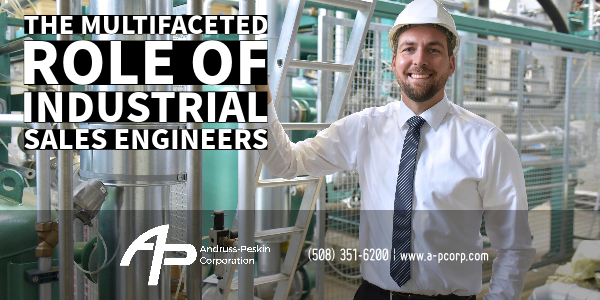A blog discussing sensors and instrumentation. New products, new technologies, and interesting applications. Types of sensors and instruments discussed include: Analyzers, Color Sensors, Displacement Sensors, Flow Sensors, Industrial Weighing, Instrumentation (Data Acquisition), Load Cells & Instrument Hardware. Machine Controls, Pressure Gauges, Pressure Sensors, Sanitary Sensors, Strain Gages, and Temperature Sensors. Courtesy of AP Corp.
Andruss-Peskin Statement on the End of Micro-Measurements Partnership: A New Chapter Begins
The Multifaceted Role of Industrial Sales Engineers
The Multifaceted Role of Industrial Sales Engineers
- Technical Expertise: Industrial sales engineers uniquely blend technical knowledge and sales acumen. Their deep understanding of engineering principles allows them to understand complex instrumentation and its applications in various industrial settings.
- Custom Solutions: Crucial in tailoring solutions to meet specific customer needs. For instance, in selecting the correct pressure measurement instrument for a particular industrial process, the sales engineer assesses factors like range, accuracy, and environmental conditions.
- Product Demonstration and Education: These professionals are skilled in demonstrating the functionalities and advantages of instruments. Their ability to educate customers about the nuances of instruments like colorimeters or thermocouples is essential for successful sales.
- Bridging Gaps: Industrial sales engineers act as a bridge between the manufacturing team and clients. They translate technical specifications into understandable terms for customers and client needs into feasible production goals for manufacturers.
- After-Sales Support: Their role extends beyond sales. Providing technical support and troubleshooting post-purchase ensures customer satisfaction and fosters long-term relationships.
Their Impact on Industries
- Quality Control: In industries where parameters like size, color, and weight are critical (e.g., pharmaceuticals, automotive), sales engineers assist in assuring the correct instruments are applied.
- Safety and Compliance: In sectors like oil and gas, accurate pressure and temperature measurements are vital for safety and regulatory compliance. Sales engineers ensure that the instruments sold meet the required standards.
- Innovation and Development: Their feedback from the field helps in innovating new instruments and improving existing ones, aligning with evolving industry requirements.
- Operational Efficiency: By recommending the most suitable instruments, they help industries optimize processes, enhancing efficiency and reducing costs.
Challenges and Opportunities
(508) 351-6200
https://a-pcorp.com
AP Corp. Voices Support for Israeli Friends & Colleagues
High-Speed Color Measurement for Modern Manufacturing
(508) 351-6200
https://a-pcorp.com
From Spot Checks to Cumulative Assessments: Understanding Noise Measurement Tools for OSHA 1910.95
The Occupational Safety and Health Administration (OSHA) is an agency of the United States Department of Labor, and it is responsible for ensuring that employers provide safe and healthful working conditions for employees in the U.S. One of the ways OSHA accomplishes its mission is by setting and enforcing standards.
OSHA standard 29 CFR 1910.95 relates explicitly to occupational noise exposure. This standard protects workers from excessive noise levels that can lead to hearing loss or other health problems.
Sound level indicators (often called sound level meters or SLMs) and dosimeters are two primary instruments used to measure occupational noise levels. Both devices help employers assess noise exposure and ensure compliance with OSHA's 1910.95 standard on occupational noise exposure.
- Sound Level Indicators (Sound Level Meters - SLMs):
- Function: An SLM measures sound pressure levels in the workplace. It provides instant readings of noise levels at a specific location and time.
- Usage:
- SLMs spot-checks or short-term measurements in specific areas or at particular workstations where noise levels might be a concern.
- They can identify areas in the workplace where further noise monitoring or controls may be necessary.
- When using an SLM, it's crucial to consider the weighting scale (typically "A" weighting for human hearing) and the response time (slow or fast).
- Data Collection: SLMs provide a snapshot of the noise level during measurement. They don't offer cumulative exposure data over time. Therefore, while SLMs can determine if a particular location is loud, they don't indicate the length of exposure to that noise level.
- Dosimeters:
- Function: Dosimeters are wearable devices that measure a worker's cumulative noise exposure over time. They provide a personal noise dose reading based on the intensity and duration of sounds for individual exposure.
- Usage:
- Dosimeters are typically clipped to a worker's clothing and worn throughout the workday. The microphone is usually positioned near the worker's ear to assess the noise exposure accurately.
- They benefit workers who move between different areas or tasks, resulting in varying noise exposures.
- Data Collection: Dosimeters continuously measure and record noise levels, providing a time-weighted average (TWA) over the period worn. This data is crucial in determining worker-level exposure exceeding permissible exposure limits (PEL) set by OSHA or other regulatory bodies.
Compliance with OSHA 1910.95:
- Employers typically start with sound level meters to identify areas or tasks with potentially hazardous noise levels.
- Employers will use dosimeters to monitor individual exposures over the work shift if areas show elevated noise or workers' tasks involve moving between varying noise environments.
- Suppose the noise levels exceed the action level (typically 85 dBA TWA over 8 hours). In that case, the employer must implement a hearing conservation program, which includes further monitoring, audiometric testing, training, and provision of hearing protection.
In summary, while sound level meters provide immediate spot readings of noise levels, dosimeters assess an individual's cumulative exposure over time. Both tools are essential for comprehensively evaluating workplace noise and ensuring compliance with occupational noise standards.
(508) 351-6200
https://a-pcorp.com






